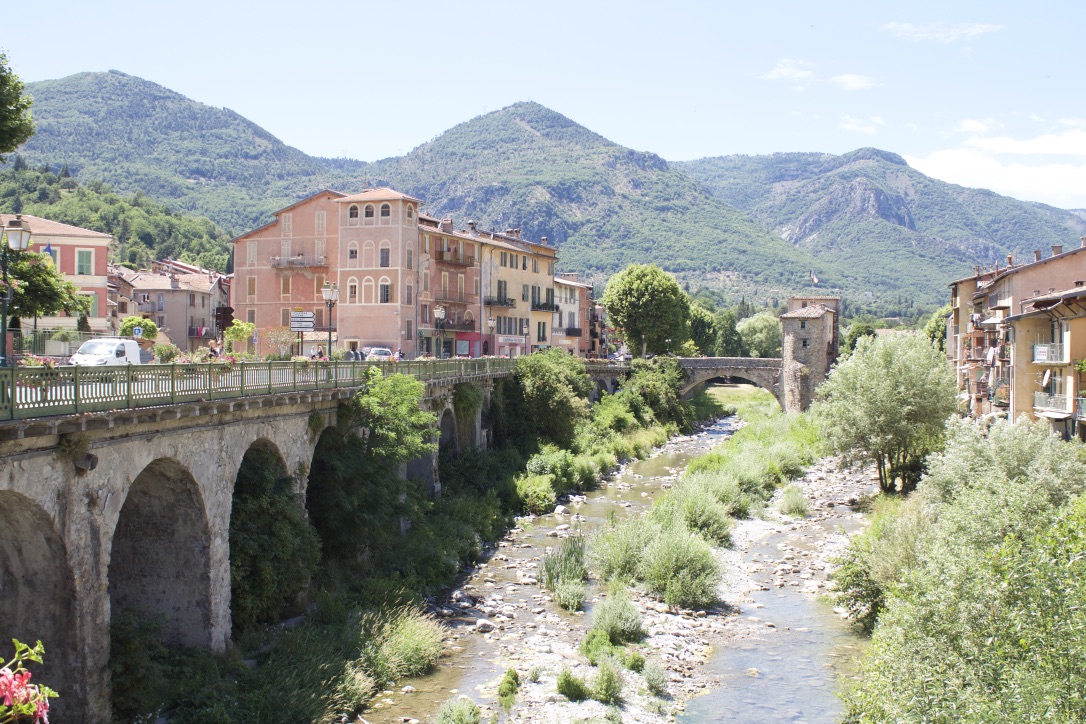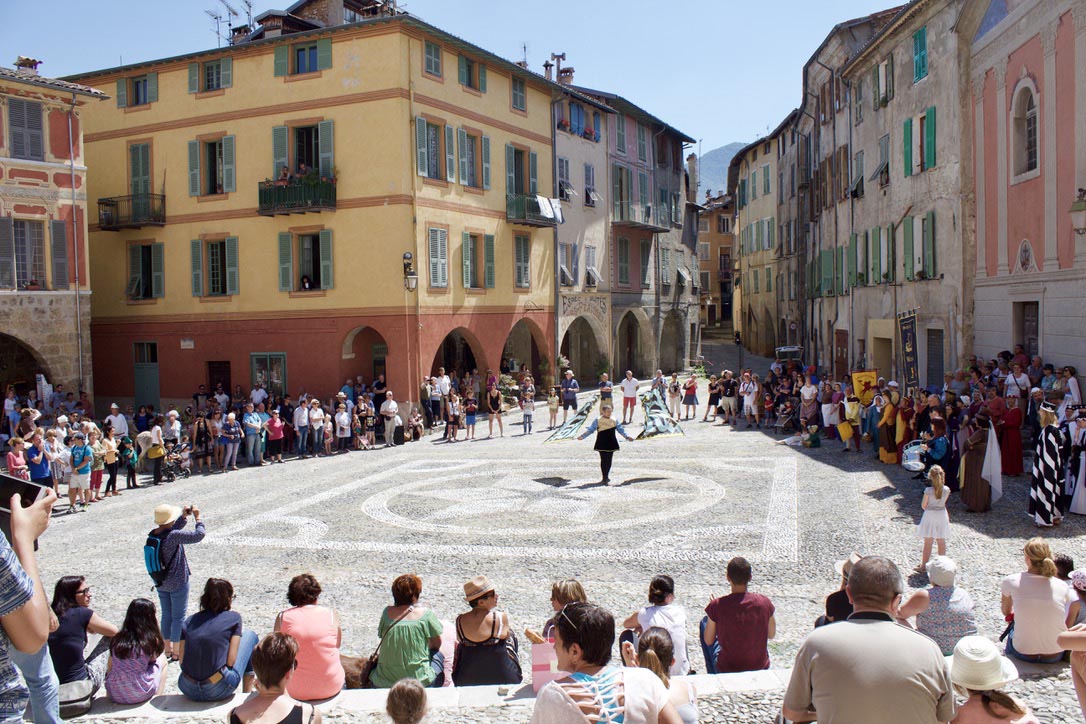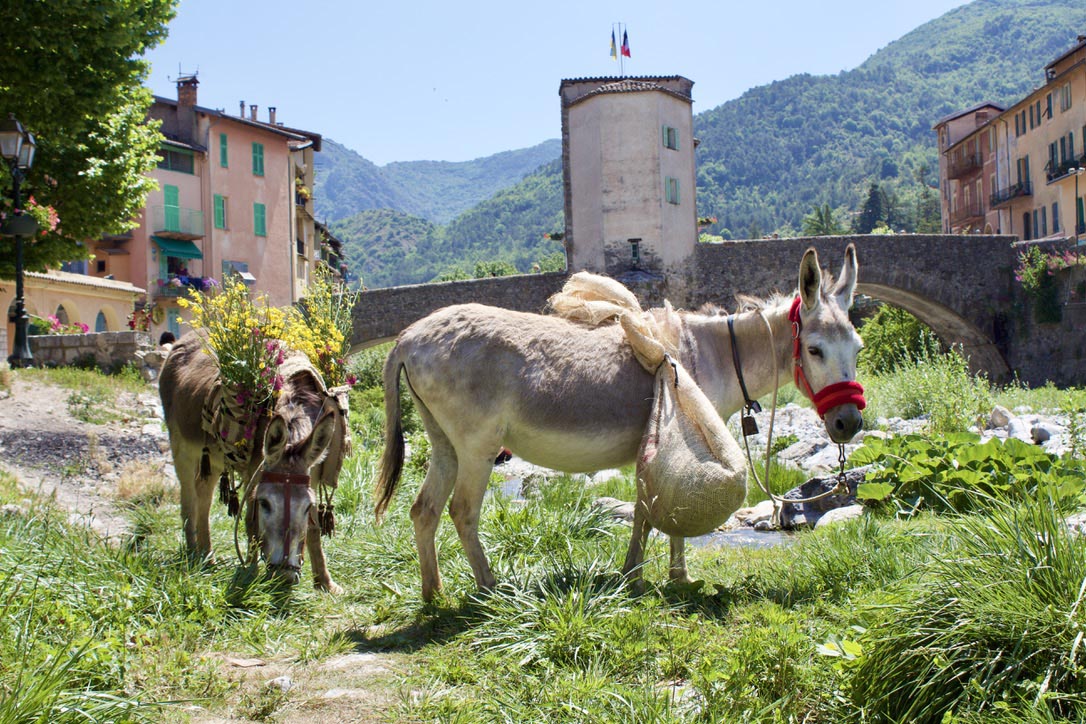SOSPEL: HISTORICAL VISIT
Sospel is located on the banks of the Bévéra River roughly 75 km in distance from Cannes in the Alpes-Maritimes department in the Provence-Alpes-Côte d'Azur region.

This small medieval village is seductive. Its allure mesmerizes one’s soul with its authenticity and its patrimony: its old toll bridge, the beautiful architectural complex of the Place Saint Michel including its church, its palaces, and houses with their arcades and decorations in trompe l'oeil, and its beautiful medieval fountain.
On the other side of the River Bévéra, one will notice the arcades dating from the Middle Ages.
From the Place Saint-Nicolas by the Rue de la République, one will encounter the Chapelle Baroque Saint-Croix. In more the present day, the Chapel of Saint-Crois has become a venue for concerts of baroque music during the verdant and pleasant warm summer months.
In the street opposite the Pont Vieux, in the direction of Place Saint Michel, there are beautiful twin windows or windows with mullions which are quite rare in the region.
The pavement in "calade" of the place of Saint Michel is dates from the late 17th and early 18th century. It is formed of gray and white pebbles.

SOSPEL: HISTORY OF THE CITY
The first traces written on the origins of Sospel date back to the 11th century. The monks of the Lérins Islands (Cannes) first mentioned Sospel in 1095. At that time, Sospel was known as Cespitellum.
The town belonged successively to the County of Ventimiglia, to the County of Provence in 1258, and finally to the County of Savoy. Founded in the 5th century, the village became a free commune of Provence and Savoy during the Middle Ages.
The Great Western Schism occurred in in Western Christendom from 1378 - 1417. The city was at the time under the aegis of the pope of Avignon and later became a bishopric. In 1370, Sospel had taken the side of the pope of Avignon against the antipope of Rome: his church then became a cathedral for a time.
A consular administration, the chief town of viguerie, a strategic square at the confluence of the Bévéra and the Merlanson, Sospel has always been an important place with an influence enhanced by the intellectual influence of the "Academy of the Literary Occupations" created in 1702 and attracted historians, chroniclers and poets.
SOSPEL: SALT ROAD
Sospel was an obligatory point on the "Route du Sel" between Nice and Turin.

Transit along the Old Bridge was the object of toll on the old salt road.
The Old Bridge is one of the most remarkable monuments to Sospel and its guilded age. Its construction dates from the beginning of the 13th century. Originally constructed from wooden timbers, it was rebuilt in stone during the year 1522.
The bridge’s strategic importance stemmed from the fact that it constituted the preferred crossing point of the river Bévéra on the salt road that connected Nice and Turin. Its central tower was operated as a toll station for salt tax collection.
Salt was at that time a particularly important commodity because, beyond its nutritional value for men and livestock, it was the only means of preserving foods such as meat and fish.
As early as the Middle Ages, sovereigns sought to take full advantage of the importance of salt as a valuable commodity and introduced a tax on salt: known as "gabelle". This indirect tax assured the regents of fixed revenues from the sale of salt. The tax was paid in the form of buying the salt: taxpayers were obliged to buy imposed quantity of salt from empowered by king farmers-supplies.
The Savoyard sovereigns identified the Nice-Turin axis as a strategic route to transport salt to the Turinese capital from the port of Nice, which itself supplied by sea from the salt pans at Hyères. In 1610, Charles Emmanuel signed a decree ordering the construction of a Nice-Turin road passing through Roya, to replace the old road via Vésubie, as it was considered to be too close the Kingdom of France. The work was completed in less than 4 years. Later, in 1780, Victor Amédée III had improved the road to make it entirely passable. The exploitation of the road reached its apogee under the reigns of the Dukes of Savoy, who understood well the economic interests at stake. In 1860, the annexation of the County of Nice by France ended exploitation of the road.
The 800 years of the Old Bridge (1217-2017) were celebrated on 04 June 2017 through numerous events: costumed animation, medieval dances, concerts ...
SOSPEL CHRISTIAN HERITAGE: THE CATHEDRAL OF SAINT-MICHEL
The Cathedral of Saint-Michel was originally built in the Romanesque style. It dates from the end of the 13th century and its bell tower of the beginning of the 13th century. The upper part of the facade is from the pre-Romanesque era.
The building was rebuilt in the baroque style in 1641 - 1762 and restored in 1888. Jean André Cuibert, a local builder, built the Cathedral of St Michel de Sospel as well as the church of Gesù, the Cathedral of Sainte Réparate in Nice or Church of the Escarène Saint Michel in the form of a Latin cross. It is the largest church in the Alpes-Maritimes.
The interior of the building is rich with altars, frescoes, gildings, altarpieces. The two interior statues are integrated into niches and represent the protectors of the town of Sospel "Saint-Hippolyte and Saint-Absende". On the left, inside the cathedral stands the "Immaculate Virgin of Sospel" made in 1520. This three-part altarpiece was made by François Bréa painter of Nice from the 15th and early 16th century centuries. On the right stands an altarpiece of the virgin of pity carved wood. The Italian organ of the Agati brothers dates from 1843. The cupola of crushed form is composed of frescoes in trompe l'oeil (optical illusion) showing the assumption of Mary.
The confraternities of Penitents began to establish themselves in Sospel from the 13th century. They were dressed in a dress or "camisou" and wearing a hood. This garment was worn on the occasion of the processions and masses. Their role was a social one and they represented a significant help and support during epidemics or burials. Activists of the social life, the penitents instated the "granite mountain" - loan of grain with a low interest. Besides the classes of the population, the confraternities also corresponded to the different districts. At Sospel there were several brotherhoods on the banks of the Bévéra.
SOSPEL: ANNUAL BAROQUE MUSIC FESTIVAL
Every year, since 1998, a baroque music festival "les Baroquiales" takes place in Sospel, which runs from 2 June until the beginning of July.